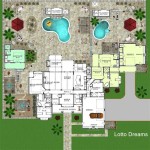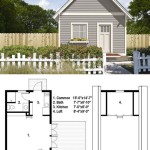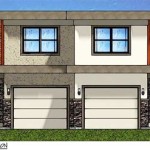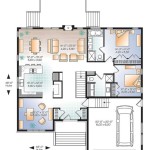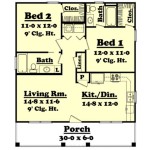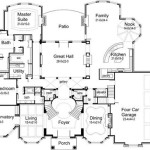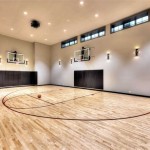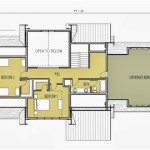1 Bedroom Ranch House Plans: Maximizing Space and Simplicity
Ranch house plans, characterized by their single-story layout and low-pitched roofs, offer a unique blend of accessibility and adaptability. While often associated with larger family homes, ranch-style designs are increasingly popular for smaller dwellings, particularly 1-bedroom configurations. These plans cater to individuals, couples, or empty-nesters seeking a manageable and comfortable living space without stairs or unnecessary square footage. This article explores the key considerations and design principles involved in creating effective and appealing 1-bedroom ranch house plans.
The appeal of a 1-bedroom ranch lies in its simplicity and functionality. The absence of stairs makes it an ideal choice for individuals with mobility limitations or those planning for aging in place. Furthermore, the compact footprint allows for efficient use of land and potentially lower construction and maintenance costs. However, maximizing the limited space requires careful planning and thoughtful design choices.
Optimizing Layout and Space Utilization
Effective space planning is paramount in a 1-bedroom ranch house. Every square foot must be utilized strategically to ensure functionality and comfort. Open floor plans that combine the living, dining, and kitchen areas are common and effective in creating a sense of spaciousness. Zoning within this open area can be achieved through furniture placement, changes in flooring, or the use of partial walls or dividers.
The bedroom should be designed as a tranquil retreat. While size is a factor, the layout and features are crucial. Ample closet space is essential for storage, minimizing clutter and maximizing the usable area within the room. A well-placed window can provide natural light and ventilation, enhancing the overall ambiance. Consider incorporating a small sitting area or reading nook within the bedroom if space allows.
The bathroom design requires careful consideration. Depending on budget and space constraints, options range from a standard full bathroom to a more compact half-bath with a separate shower room. Regardless of the configuration, efficient use of space is critical. Wall-mounted sinks and toilets can free up floor space, while strategically placed storage cabinets can help keep the area organized.
The kitchen, though typically smaller than in larger homes, should be functional and efficient. A well-designed kitchen layout, such as a galley or L-shaped design, can optimize workflow and storage. Incorporating features like pull-out shelving, under-cabinet lighting, and a thoughtfully placed pantry can further enhance functionality.
Beyond the core living spaces, consider the importance of entryways and hallways. Minimizing hallway space can free up valuable square footage for other areas. A well-defined entryway, even in a small home, can create a welcoming atmosphere and provide a space for coats, shoes, and other essentials. The inclusion of a mudroom or small laundry area near the entrance can further enhance the practicality of the design.
Designing for accessibility is a key consideration, especially for aging in place. Wider doorways, lever handles on doors, and roll-in showers can ensure that the home remains accessible for individuals with mobility limitations. These features not only enhance accessibility but also add to the overall universal design appeal of the home.
Enhancing Natural Light and Ventilation
Natural light and ventilation are crucial for creating a comfortable and inviting living environment, particularly in smaller homes where space can feel constrained. Maximizing natural light can make a small space feel larger and more open. Strategic placement of windows, skylights, and even glass doors can significantly impact the amount of natural light that enters the home.
Large windows, strategically placed to capture sunlight throughout the day, can brighten interior spaces and reduce the need for artificial lighting. Consider the orientation of the house when planning window placement to maximize solar gain in the winter and minimize heat gain in the summer. Low-E glass can also help regulate temperature and reduce energy costs.
Skylights are an excellent option for bringing natural light into areas where windows are not feasible, such as bathrooms or hallways. They can also add architectural interest to the interior. Operable skylights can provide ventilation, allowing warm air to escape and promoting natural airflow.
Proper ventilation is essential for maintaining indoor air quality and preventing moisture buildup. Cross-ventilation, achieved by placing windows on opposite sides of the house, can promote natural airflow and reduce the need for air conditioning. Ceiling fans and exhaust fans in bathrooms and kitchens can further enhance ventilation. Pay attention to prevailing wind directions and landscape features that may affect airflow.
The integration of outdoor living spaces, such as decks or patios, can extend the living area and create a sense of openness. These spaces can be accessed through sliding glass doors or French doors, which also provide ample natural light. Consider landscaping elements, such as trees and shrubs, to provide shade and privacy.
Light colors and reflective surfaces can also enhance the effect of natural light. Light-colored walls and ceilings reflect light, making the space feel brighter and more open. Mirrors can be strategically placed to reflect light and create the illusion of more space. Furniture with light finishes and reflective accents can also contribute to a brighter and more airy atmosphere.
Selecting Materials and Finishes
The choice of materials and finishes plays a significant role in the overall aesthetic and functionality of a 1-bedroom ranch house. Durable, low-maintenance materials are often preferred for their longevity and ease of upkeep. Consider the overall style of the home and choose materials that complement the design.
For exterior finishes, options include brick, stone, siding, and stucco. Each material offers a different look and level of maintenance. Brick and stone are durable and require minimal maintenance, but they can be more expensive than siding. Siding is a more affordable option and comes in a variety of styles and colors. Stucco provides a smooth, modern look and is well-suited for warmer climates.
Interior finishes should be chosen for their durability, aesthetics, and ease of maintenance. Hardwood flooring is a popular choice for its durability and timeless appeal. Tile is a practical option for bathrooms and kitchens, as it is water-resistant and easy to clean. Laminate flooring is a more affordable alternative to hardwood and offers a similar look.
Countertops in the kitchen and bathroom should be durable and easy to clean. Quartz and granite are popular choices for their durability and aesthetic appeal. Laminate countertops are a more affordable option and come in a variety of patterns and colors. Stainless steel sinks are durable and easy to maintain.
The choice of paint colors can significantly impact the overall ambiance of the home. Light colors can make a space feel larger and brighter, while darker colors can create a cozy and intimate atmosphere. Neutral colors are a versatile choice and can be easily paired with different furniture and accessories.
Hardware and fixtures, such as door handles, faucets, and lighting fixtures, should be chosen for their style and functionality. Choose hardware and fixtures that complement the overall design of the home. LED lighting is an energy-efficient option that can save money on electricity bills.
Consider sustainable materials and finishes to reduce the environmental impact of the home. Recycled materials, such as recycled glass countertops and reclaimed wood flooring, can add character to the home while minimizing waste. Low-VOC paints and finishes can improve indoor air quality.
The selection of appliances should also be considered carefully. Energy-efficient appliances can save money on utility bills and reduce the environmental impact of the home. Consider the size of the appliances and choose models that are appropriate for the size of the kitchen.
By carefully selecting materials and finishes, it is possible to create a 1-bedroom ranch house that is both stylish and functional, while also being durable and easy to maintain.

Ranch Style House Plan 1 Beds Baths 896 Sq Ft 771 One Bedroom Plans Small Floor

Ranch Style House Plan 1 Beds Baths 962 Sq Ft 135 Bedroom Plans 20x40

Country Ranch House Plan With 1 Bedroom 72971da Architectural Designs Plans

Ranch Style House Plan 1 Beds Baths 1200 Sq Ft 21 128 Houseplans Com

House Plan Details Plans Small Ranch Style One Story

7 Classic Ranch Style Tiny Home Floor Plans Micro House

Zinnia A Charming Modular Ranch Signature Building Systems

House Plan One Bedroom Plans Small Floor 1

House Plan 51429 Ranch Style With 1200 Sq Ft 2 Bed 1 Bath

Ranch Home 1 Bedrm 5 Baths 904 Sq Ft Plan 141 1325

